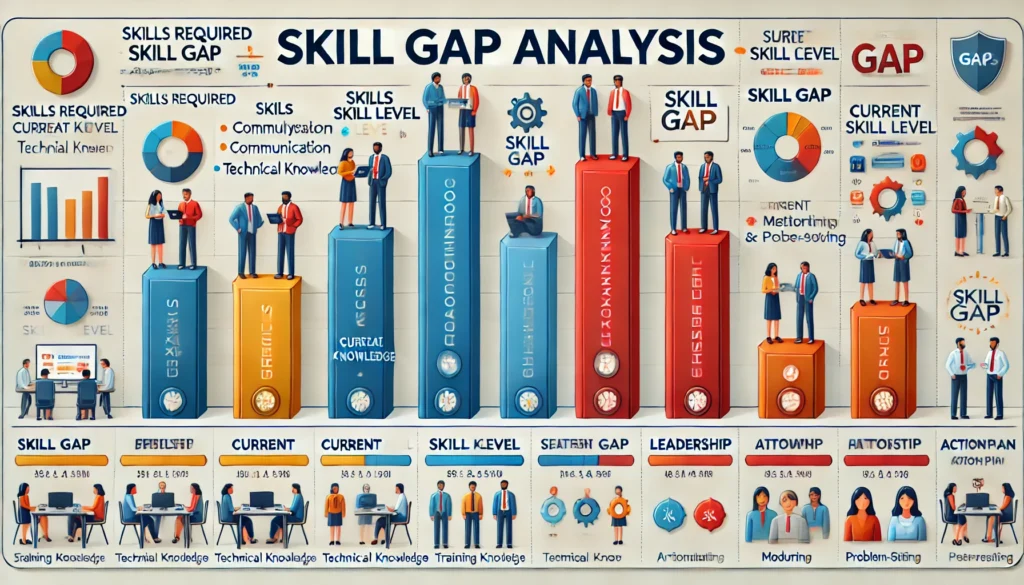Navigating Skill Gap Analysis: Identifying Employee Development Needs

Introduction to Skill Gap Analysis
In the contemporary work environment, characterized by rapid technological advancements and fluctuating market demands, skill gap analysis has emerged as a critical process for organizations. Skill gap analysis involves identifying the discrepancies between the skills possessed by employees and the skills required to meet organizational objectives effectively. This structured approach serves as a pivotal tool for organizations looking to remain competitive and responsive to changes in their respective industries.
The significance of conducting a skill gap analysis cannot be overstated. Organizations face challenges in keeping their workforce adequately equipped to handle new technologies, methodologies, and market expectations. As industries evolve, an increasing number of employees may find their skill sets outdated or insufficient. Consequently, identifying these gaps is essential not only for enhancing individual employee performance but also for ensuring the organization’s overall success in a competitive landscape.
A comprehensive skill gap analysis enables organizations to take informed steps toward employee development and training. It fosters a culture of continuous learning, encouraging employees to acquire the necessary skills that align with both their personal career growth and the strategic goals of the organization. Furthermore, by pinpointing specific areas where employees may lack proficiency, organizations can tailor training programs and resources to effectively bridge these gaps.
In an era where agility and innovation are key drivers for business success, neglecting skill gap analysis can pose significant risks. Organizations that proactively engage in this assessment not only empower their employees but also enhance their capacity to adapt, innovate, and thrive. Therefore, understanding and implementing a skill gap analysis is vital for any organization aiming to navigate the complexities of the modern workforce successfully.
The Skill Gap Analysis Process
Conducting a skill gap analysis is a systematic process that allows organizations to evaluate the alignment between their employees’ current skills and the skills required for effective performance in specific job roles. The first step in this process involves clearly defining the job roles and responsibilities within the organization. This clarity is crucial, as it establishes the framework for understanding the skills that employees need to succeed in their positions. By outlining job expectations, companies can ensure that all stakeholders are aligned on what constitutes effective performance.
Once job roles are defined, the next step is to assess the existing skills of employees. This assessment can be conducted through various methods, including surveys, self-assessments, and performance appraisals. It is essential to gather information on both technical and soft skills that employees currently possess. Evaluating the skill set of the workforce provides a baseline against which the required skills can be compared.
After the current skills inventory is established, the analysis proceeds to compare these skills with the required skills for each role. This comparison is critical as it highlights the disparities between what employees can do and what is necessary for their roles. Identifying these gaps helps organizations to pinpoint specific areas that may hinder performance, productivity, and overall success. It is important to be thorough in this comparison to ensure that all relevant competencies are considered.
Finally, the outcomes of the gap analysis must be carefully documented, outlining areas for development and training opportunities. Organizations can then prioritize these gaps based on their strategic goals, enabling them to develop targeted training programs that will enhance employee skills. Ultimately, a well-conducted skill gap analysis not only benefits the individual employees but also aligns organizational capabilities with business objectives, fostering growth and effectiveness.
Role of Analytics in Identifying Skill Gaps
In today’s rapidly evolving workplace, organizations are striving to maintain a competitive edge by ensuring their workforce possesses the necessary skills. Analytics plays a crucial role in identifying skill gaps among employees, enabling companies to address development needs effectively. By leveraging various data collection methods, organizations can gather insightful information regarding employee competencies and performance levels.
One of the primary methods of data collection includes employee assessments, which may consist of self-evaluations, peer reviews, and performance appraisals. These assessments provide a comprehensive view of employee skills and highlight areas that require improvement. Additionally, organizations can utilize surveys and feedback mechanisms that solicit input directly from employees regarding their perceived skill levels and training needs. This qualitative data can be instrumental in shaping an organization’s approach to employee development.
To analyze the collected data, various analytics tools are available, such as learning management systems (LMS) with built-in analytics capabilities, business intelligence software, and specialized workforce analytics platforms. These tools allow organizations to track performance metrics, identify trends in skill competencies, and compare data across different departments or roles. For example, predictive analytics can be used to forecast future skill requirements based on market trends and organizational goals, thereby enabling proactive workforce planning.
The insights provided by these analytics tools are vital for making informed decisions regarding employee training and development initiatives. With a clear understanding of existing skill gaps, organizations can allocate resources efficiently, design targeted training programs, and implement mentorship opportunities. Ultimately, data-driven decision-making not only enhances individual employee performance but also aligns workforce development with organizational objectives, ensuring that staff members are equipped to meet present and future challenges.
Establishing Initial Training Focus
Determining initial training priorities is a critical step in effectively addressing skill gaps within an organization. An aligned approach ensures that employee development initiatives not only meet individual learning needs but also support broader organizational objectives. To initiate this process, companies should first conduct a comprehensive skill gap analysis, which identifies specific areas where employees may require additional training or enhancement of skills. This analysis typically involves evaluating current performance levels against desired outcomes, which can reveal important insights into where gaps exist.
Once these gaps are identified, organizations can begin to prioritize training programs based on both urgency and impact. Prioritization should consider factors such as the frequency of tasks requiring the underdeveloped skills, the alignment of these skills with organizational strategy, and overall employee performance. In this context, organizations can employ a matrix to categorize skills into critical, moderate, and low-priority categories. This categorization assists in efficiently allocating resources and training efforts toward the most significant gaps.
Furthermore, developing targeted training programs requires understanding the learning preferences and styles of employees. Various methodologies, such as e-learning modules, workshops, and mentorship opportunities, can be integrated to cater to diverse learning needs. By offering tailored training initiatives, employers not only improve the likelihood of knowledge retention but also engage employees by demonstrating a commitment to their professional development.
Aligning training initiatives with performance objectives ensures that training is not just an isolated endeavor but part of a continuous improvement process. This alignment reinforces the importance of training by linking it directly to measurable performance outcomes, which can lead to enhanced productivity and employee satisfaction. By establishing a clear focus in initial training efforts, organizations set the foundation for a robust employee development strategy that fosters continuous growth and aligns with evolving business goals.
Key HR Metrics for Skill Gap Analysis
Identifying the right metrics is crucial for conducting an effective skill gap analysis. These metrics provide valuable insights that enable organizations to align employee capabilities with business goals, thereby enhancing overall performance. Below are ten essential HR metrics that should be considered in this process.
1. Skill Assessment Scores: This metric involves evaluating employee competencies against required skill sets for their current roles. By assessing gaps, organizations can prioritize training initiatives that directly address deficiencies.
2. Training Effectiveness Ratings: Evaluating the success of training programs is vital. By collecting feedback from participants, organizations can identify areas for improvement and ensure that training efforts yield meaningful results.
3. Competency Levels: This measures how well employees perform specific tasks. Establishing clear competency levels ensures that employees possess the necessary skills, helping HR to identify where additional development is required.
4. Employee Turnover Rates: High turnover rates may indicate dissatisfaction related to skill utilization. Monitoring these rates can reveal insights into whether employees feel equipped to perform their roles effectively.
5. Project Completion Rates: Tracking how often projects are completed on time and within budget can provide insights into skill gaps. Delays may point to a lack of necessary competencies within teams.
6. Training Participation Rates: Reviewing how many employees engage in development opportunities can highlight a commitment to learning or reveal barriers preventing attendance.
7. Promotion Rates: Analyzing the percentage of employees promoted within specific time frames helps gauge whether skill development initiatives effectively prepare individuals for advancement.
8. Performance Review Ratings: Regular performance evaluations help assess employee skills and performance trends, allowing HR to pinpoint areas requiring further training.
9. Employee Satisfaction Scores: High satisfaction levels correlate with effective skill utilization. Monitoring these scores can reveal whether employees perceive that their skills are being effectively applied and developed.
10. Peer Feedback and 360-Degree Reviews: Gathering feedback from colleagues can provide a well-rounded view of an employee’s skill level and identify strengths and weaknesses that may not be apparent through self-assessment.
These metrics, when analyzed collectively, yield actionable insights into the workforce’s skill levels and development needs, enabling effective strategic planning and resource allocation.
Implementing Training Programs to Close Skill Gaps
Addressing skill gaps within an organization requires a structured approach to implementing training programs that cater to the identified needs of employees. Various methods can be utilized to ensure effective skill enhancement, including workshops, e-learning modules, and on-the-job training. Each method has its own set of advantages and can be selected based on the specific requirements of the workforce and the nature of the skills being imparted.
Workshops, often held in a classroom setting, enable interactive learning and facilitate peer-to-peer discussion. They encourage participants to engage actively, thereby enhancing the retention of concepts. On the other hand, e-learning offers flexibility, allowing employees to learn at their own pace, making this method ideal for busy professionals. The convenience of access to training materials any time and from any location contributes to a higher completion rate among learners. Furthermore, on-the-job training is instrumental in allowing employees to gain hands-on experience, which is crucial for skills that require practical application. This method ensures that learning is contextual and directly applicable to day-to-day operations.
To achieve real progress in mitigating skill gaps, feedback loops play a vital role. Establishing mechanisms for feedback allows organizations to understand the effectiveness of their training programs and make necessary adjustments. Collecting feedback from participants immediately after training sessions can aid in gauging their understanding and satisfaction levels. Additionally, regular assessments should be conducted to measure knowledge retention and skills application over time. This continuous evaluation not only refines the training procedures but also reinforces a culture of lifelong learning.
To encapsulate the success of any training program, organizations should track and analyze performance metrics post-implementation. By establishing clear Key Performance Indicators (KPIs), companies can determine the impact of the training on employee performance, productivity, and overall business outcomes. This data-driven approach ensures that organizations remain proactive in adapting their training strategies and reinforcing employee development continuously.
Evaluating the Effectiveness of Skill Gap Analysis
Evaluating the effectiveness of skill gap analysis is crucial to ensure that the identified development needs are being addressed adequately. Organizations can start by establishing clear performance metrics that align with the objectives of the skill gap analysis. These metrics may include specific key performance indicators (KPIs) that measure both individual and organizational growth over time. By monitoring these KPIs, organizations can quantitatively assess whether the training programs implemented are successful in bridging the identified skill gaps.
In addition to quantitative measures, soliciting feedback from employees who participate in training is essential. Surveys, interviews, or feedback sessions can provide qualitative insights into the effectiveness of the training content and delivery methods. Employee perceptions can reveal whether they feel more equipped to perform their roles and whether the training truly addresses their skill needs. This direct feedback mechanism can serve as a vital tool to refine and enhance training programs further.
Another critical aspect of evaluating the effectiveness of skill gap analysis is revising training programs based on the outcomes observed. Companies should conduct regular follow-ups to assess the application of learned skills in the workplace. This includes not only evaluating the immediate effects post-training but also the sustainability of skill acquisition over time. Continually updating and adapting the training curriculum based on demonstrated outcomes ensures that the organization remains responsive to development needs.
Lastly, it is beneficial to encourage a culture of continuous improvement, where learning and development are regularly revisited. This dynamic approach will not only help in effectively narrowing skill gaps but also foster a workforce that is agile and responsive to the changing demands of the industry.
Challenges in Conducting Skill Gap Analysis
Conducting a skill gap analysis is pivotal for organizations striving to enhance employee competencies and align workforce capabilities with strategic goals. However, various challenges can impede this process, ultimately affecting its effectiveness. One prominent issue arises from data privacy concerns. Organizations must ensure that any data collected about employees, their skills, and development needs is handled in compliance with relevant data protection laws and regulations. Failure to do so can not only lead to legal repercussions but also diminish trust among employees, making them less inclined to participate actively in the analysis process.
Another challenge frequently encountered is employee resistance to training. Individuals may be apprehensive about undergoing assessments that reveal their weaknesses or fear the implications of such evaluations on their job security. This resistance can hinder honest participation, leading to skewed results in the analysis. Organizations must foster a culture of continuous learning and improvement, emphasizing that skill gaps represent growth opportunities and not shortcomings. Engaging employees in discussions about the purpose and advantages of the skill gap analysis can mitigate these fears and encourage proactive involvement.
Furthermore, the necessity for ongoing assessment is often overlooked. A one-time skill gap analysis may provide a snapshot of the current workforce capabilities, but skills and organizational objectives evolve over time. Therefore, implementing a continuous evaluation framework becomes essential. Regular reviews and updates to the skill gap analysis process can help organizations stay ahead of industry changes, enhance employee capability, and remain competitive. Leveraging technology, such as Learning Management Systems (LMS), can streamline the tracking and development of employee skills over time, ensuring that the organization meets its evolving needs effectively.
The Future of Skill Gap Analysis in Workforce Development
The landscape of workforce development is rapidly evolving, driven by advancements in technology and an increasing prevalence of remote work arrangements. As organizations strive to maintain competitiveness, skill gap analysis is becoming not just a necessity but a critical component of strategic planning. One notable trend shaping the future of skill gap analysis is the integration of sophisticated data analytics and artificial intelligence. These technologies enable organizations to evaluate employee skills on a deeper level, identify skill gaps more accurately, and tailor development programs to meet specific needs.
Additionally, the rise of remote work has fundamentally altered the approach to employee training and development. Organizations are now required to consider diverse learning modalities that cater to a distributed workforce. Virtual training programs, e-learning platforms, and collaborative tools are becoming essential in addressing the skill gaps that remote workers may face. This shift necessitates a re-evaluation of traditional skill assessment methods, pushing companies to adopt more flexible and accessible approaches for skill acquisition.
Moreover, the need for continuous learning is gaining prominence as industries evolve at an unprecedented pace. Employees must remain adaptable, embracing lifelong learning to keep up with changing demands. Organizations will increasingly emphasize fostering a culture that encourages ongoing skill development, ranging from formal training sessions to informal knowledge-sharing practices. This proactive stance not only helps to bridge skill gaps but also enhances employee engagement and retention.
In conclusion, the future of skill gap analysis within workforce development lies in embracing technological advancements, accommodating remote work dynamics, and prioritizing continuous learning initiatives. By adopting a forward-thinking approach to skill assessment and development, organizations can better align their workforce capabilities with the ever-changing market demands, ensuring long-term success and adaptability.






Responses